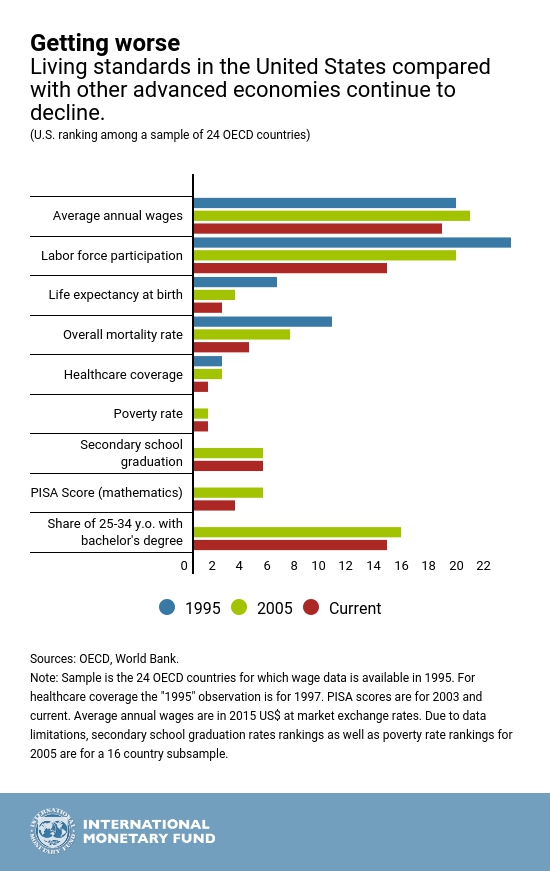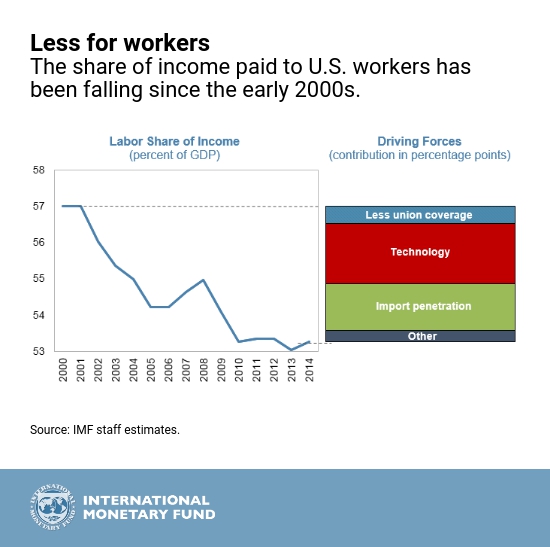
Workers using a metal saw in Tacoma, Washington, United States: policies need to be realigned to raise productivity (photo: Jetta Productions Blend Images/Newscom)
Ten Ways to Expand U.S. Growth
July 27, 2017
With the economy at full employment, the United States will need to gradually remove both fiscal and monetary support, while intensifying efforts to address multiple constraints on its medium-term growth prospects, the IMF says in its latest economic report.
Related Links
These constraints include weak productivity growth, an aging population, falling labor force participation, an increasingly polarized income distribution, and high levels of poverty. These growing headwinds are made worse by a share of income paid to workers that is nearly 4 percentage points lower than that in the early 2000s, a middle class that has shrunk to its smallest size over the past 30 years, and a potential growth rate that is virtually the lowest since the 1940s.

What can be done? The IMF report offers some solutions:
- Getting the economic policy mix right
- Reforming the tax system There is a need to simplify the system—with lower tax rates and fewer exemptions—and redesign it to create incentives for people to enter the labor force, decrease income polarization, and support low- and middle-income households. An increase in revenue can be sought from a broad-based federal consumption tax, a carbon tax, and a higher federal gas tax.
- Improving infrastructure Underinvestment in infrastructure has held back private sector productivity, long-term growth, and job creation. There is a case for a sizable increase in public spending on maintenance, repairs, and new infrastructure projects, within the constraint of deficit and debt reduction.
- Revitalizing trade Promoting a level playing field in trade is favorable for the United States and elsewhere. There is scope to modernize trade agreements, including the North American Free Trade Agreement, in a way that is mutually beneficial for all participants. The United States would gain by keeping its markets open as it pursues new or amended trade agreements.
- Supporting low- and middle-income households Improving educational opportunities and outcomes, offering childcare support for low- and middle-income families, and introducing paid family leave would encourage labor supply, raise human capital, and help reduce income polarization. Similarly, expanding the Earned Income Tax Credit, increasing the federal minimum wage, and improving the design of social assistance programs would help increase work incentives and support the most vulnerable.
- Adopting a skills-based immigration reform This would enhance labor force participation and productivity, while helping to ease the medium-term fiscal challenges.
- Protecting the financial sector Important gains have been made in strengthening the financial oversight structure since the global financial crisis. There is scope to fine-tune some aspects of the system, notably to reduce the compliance burden for smaller banks. However, the current approach to regulation, supervision, and resolution should be preserved.
- Simplifying federal regulations This, together with harmonizing rules across states, could stimulate job creation and growth. Care should be taken to avoid negative consequences from such changes for the environment, workplace safety, or protections for lower-income workers.
- Strengthening healthcare coverage Healthcare policies should aim at protecting the gains in coverage achieved since the financial crisis, particularly for those at the lower end of the income distribution. Doing so will have positive implications for productivity, well-being, and labor force participation. At the same time, the system will need to contain healthcare costs.
- Minimizing the unintended consequences of technology and import penetration A recent IMF study shows that the decline in the U.S. share of income that is paid to workers is broad-based across states and industries, but that the extent of the fall varies greatly. Exploiting a new data set on the characteristics of occupations and other sources, the study finds that in addition to changes in labor institutions, technological change, and different forms of trade integration have lowered the labor share. In particular, the fall was largest, on average, in industries that saw a high initial intensity of “routinizable” occupations, steep declines in unionization, and a high level of import penetration—which captures competition from abroad to what domestic firms sell plus how much imported inputs these firms use. Quantitatively, the study finds that the bulk of the effect comes from changes in technology that are linked to the automation of routine tasks, followed by import penetration. Policies that help labor adjust—such as programs that upgrade workers’ skills—will be needed.
Fiscal policy should aim for a gradual and sustained reduction in the general government deficit—brought about by both higher revenues and lower spending—to put public debt on a downward path.
On the monetary front, the Fed should continue to gradually raise interest rates in light of incoming data, while reducing its holdings of securities in a predictable and well-communicated manner to avoid undue market volatility.








